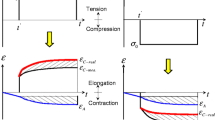Abstract
In structural elements consisting of concretes of different ages, physical and chemical deformations induced by heat release and autogenous shrinkage during the hydration of new concrete are restrained by the old concrete. Depending on the amplitude of these deformations and on the degree of restraint of the hybrid element, full-depth cracks can be induced in the new concrete layer at an early age. An experimental investigation on four hybrid elements was conducted to study this early age behaviour. The temperature evalution and global strains (measured using optical fiber sensors) during hydration are presented. Comparison of the experimental results with a numerical model shows that autogenous shrinkage has the most important influence on the evolution of the strains and internal stresses in the tested hybrid elements at early age.
Résumé
Lors de la construction d'éléments de structure formés de bétons d'âges différents, les déformations physico-chimiques induites par le dégagement de chaleur et par le retrait endogène au cours de l'hydratation du nouveau béton sont entravées par le vieux béton. En fonction de l'amplitude de ces déformations et du degré d'entrave de la structure hybride, des fissures traversantes peuvent être induites au jeune âge dans la nouvelle couche. Des mesures de température et de déformations globales obtenues à l'aide de capteurs à fibres optiques durant l'hydratation de la nouvelle couche de quatre éléments hybrides sont présentées. Lors de la validation de la modélisation numérique proposée, l'influence prépondérante du retrait endogène sur l'évolution des déformations et des autocontraintes induites dans les éléments hybrides testés a pu être confirmée.
Similar content being viewed by others
References
Emborg, M., ‘Thermal stresses in concrete structures at early ages’, Doctoral thesis, Luleå University of Technology, (1989).
Krauss, P. D. and Rogalla, E. A., ‘Transverse cracking in newly constructed bridge decks’, NCHRP Report 380, Transortation Research Board, National Research Council, (1996).
Bissonnette, B., ‘Le fluage en traction: un aspect important de la problématique des réparations minces en béton’, Doctoral thesis of Laval University, Quebec City, Canada (1996).
Martinola, G. and Wittmann, F. H., ‘Application of fracture mechanics to optimize repair mortar systems’, in ‘Fracture Mechanics of Concrete Structures’, Proceedings of FRAMCOS-2, F. H. Wittmann Ed., Aedificatio, (1995), 1481–1492.
Sadouki, H. and van Mier, J. G. M., ‘Simulation of hygral crack growth in concrete repair systems’,Mater. Struct. 30 (1997), 518–526.
Bernard, O., ‘Comportement à long terme des éléments de structure formés de bétons d'âges différents’, Doctoral thesis, Swiss Federal Institute of Technology no2283, Lausanne, Switzerland, (2000).
Acker, P., ‘Comportement mécanique du béton: apports de l'approche physico-chimique’, LPC Research Report no152, LCPC, Paris, France (1988).
Roelfstra, P. E., Salet, A. M. and Kuiks, J. E., ‘Defining and application of stress-analysis-based temperature difference limits to prevent early-age cracking in concrete structures’, in ‘Thermal cracking in concrete at early age’, Proceedings no. 25 of the International RILEM Symposium, Munich, (1994), 273–280.
Koenders, E. A. B. and van Breugel, K., ‘Numerical modelling of self-desiccation of hardening cement paste’,HERON 43 (2) (1998).
Bažant, Z. P. and Wu, S. T., ‘Rate-type creep law of aging concrete based on Maxwell chain’,Mater. Struct. 17 (37) (1974), 45–52.
Brühwiler E. Bernard, O. and Wolf, S., ‘Concrete-concrete composite elements for the widening of a bridge deck. Measures to limit crack formation in the young concrete’,Beton- und Stahlbetonbau (3) (2000), 158–166 (only available in German).
Le Châtelier, H., ‘Sur les changements de volume qui accompagnent le durcissement des ciments’,Bulletin de la Société de l'Encouragement pour l'Industrie Nationale 5 (1900).
Hua, C., ‘Analyses et modélisation du retrait d'autodessiccation de la pâte de ciment durcissante’, Doctoral thesis of the École Nationale de Ponts et Chaussées ENPC, Paris, France, (1992).
Tazawa, E., ‘Autogenous shrinkage of concrete’, Proceedings of the International Workshop organized by the Japan Concrete Institute, edited by E. Tazawa, (1998).
Hellmich, C., Ulm, F.-J. and Mang, H., ‘Multisurface chemoplasticity. I: Material model for shotcrete’,Journal of Engineering Mechanics ASCE 125 (6) (1999), 692–701.
Eyring, H., ‘Viscosity, plasticity and diffusion as examples of absolute reaction rates’,Journal of Chem. Phys. 14 (1936), 283–291.
Bjøntegaard, Ø. and Sellevold, E. J., ‘Interaction between thermal dilation and autogenous deformation in high performance concrete’, in ‘Shrinkage of concrete—Shrinkage 2000’, Proceedings PRO17 of the International RILEM Workshop, edited by V. Baroghel-Bouny and P.-C. Aïtcin, (2000).
Inaudi, D., ‘Fiber optic sensor network for the monitoring of civil engineering structures’, Doctoral thesis, Swiss Federal Institute of Technology, Lausanne no1612, Switzerland, (1997).
Bernard, O., ‘Comportement à long terme des éléments de structure formés de bétons d'âges différents’, Test report no96.01.01, (2000).
Glisic, B., ‘Fibre optic sensors and behavior in concrete at early age’, Doctoral thesis, Swiss Federal Institute of Technology, Lausanne no2186, Switzerland, (2000).
Roelfstra, P., ‘A numerical approach to investigate the properties of concrete-numerical concrete’, Doctoral thesis, Swiss Federal Institute of Technology, Lausanneo788, Switzerland, (1989).
Bažant, Z. P. and Chern, J. C., ‘Concrete creep at variable humidity: constitutive law and mechanism’,Mater. Struct. 18 (103) (1985), 1–20.
Author information
Authors and Affiliations
Additional information
Editorial Note Dr. Olivier Bernard is a RILEM Affiliate Member. He participates in RILEM TC 181-EAS ‘Early age shrinkage induced stresses and cracking in cementitious systems’. Prof. Eugen Brühwiler is a RILEM Senior Member and Staff Member. He works at EPFL, a RILEM Titular Member and participates as a corresponding member in RILEM TC NEC ‘Non-destructive evaluation of the “covercrete” (concrete cover)’.
Rights and permissions
About this article
Cite this article
Bernard, O., Brühwiler, E. Influence of autogenous shrinkage on early age behaviour of structural elements consisting of concretes of different ages. Mat. Struct. 35, 550–556 (2002). https://doi.org/10.1007/BF02483123
Received:
Accepted:
Issue Date:
DOI: https://doi.org/10.1007/BF02483123




